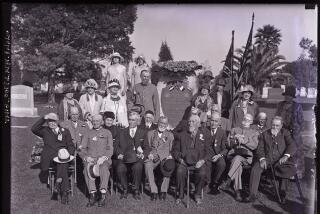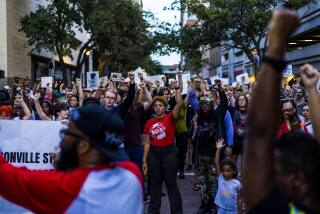Book review: ‘Red Summer’ by Cameron McWhirter
Red Summer
The Summer of 1919 and the Awakening of Black America
Cameron McWhirter
Henry Holt: 368 pp., $30
From April to October 1919, a wave of racial violence swept across the United States. A bloody series of at least 52 lynchings and 25 major riots that began in the South also consumed major Northern cities including Chicago and brought the nation’s racial woes, literally, to the gates of the White House.
Lynchings and white mob attacks on black neighborhoods were nothing new in the U.S., writes Wall Street Journal reporter Cameron McWhirter in his new book, “Red Summer.” What was different in 1919, McWhirter notes, was that “African Americans fought back in large numbers. …The economic, social and political dynamics of black-white relations were changing.” This was a pivotal moment in the struggle for African American civil rights, and a precipitating factor in these changes in black-white relations was World War I.
African American soldiers returned from Europe in a militant mood. “We have helped to gain the Victory for Democracy and we must share the fruits,” wrote one black veteran. The willingness of white America to share those fruits can be judged from the comments of Mississippi Gov. Theodore Bilbo after he refused to stop the lynching of an accused rapist in June 1919: “This is a white man’s country,” he declared, “and any dream on the part of the Negro race to share social and political equality will be shattered.”
Bilbo blamed the French for putting such dreams in black soldiers’ heads. Atty. Gen. A. Mitchell Palmer and his subordinate J. Edgar Hoover insisted that America’s Negroes were being stirred up by Bolsheviks and other outside agitators. On the contrary, McWhirter makes clear in his carefully researched, briskly narrated account of this difficult period in our national history, African Americans were increasingly disinclined to take advice from even well-meaning whites. The NAACP, founded in 1909 by a primarily white group of Northern liberals, was transformed by the events of 1919 into America’s premier civil rights organization, led by African Americans from the South.
It was NAACP field secretary James Weldon Johnson who coined the phrase “Red Summer” to describe this deadly season. McWhirter covers eight incidents in depth. Each reveals particular aspects of a general pattern: black self-assertion or reports of black crime met by white violence, which provoked African Americans to defend themselves and in some cases to go on the attack.
The new spirit was evident in Longview, Texas, where Samuel L. Jones was accused in early July of writing an “offensive” article in the Chicago Defender. The article claimed that a local man was lynched because a white woman was in love with him. Rather than fleeing town, Jones remained in his home with 25 armed friends. When a white mob tried to storm the house, Jones’ defenders opened fire and killed one man. The mob later burned down the house and several other black-owned buildings. Jones escaped and headed for Chicago — an ironic choice, since it was the scene, on July 27, of the most widespread violence of the summer, which erupted after a black teenager was stoned and drowned on a South Side beach.
When the Illinois state militia rolled into Chicago three days later, they found most African Americans relieved to see them. “[Negroes] acted largely in self-defense,” a militia captain later recalled, “aggravated by very real fear of a general massacre.” Indeed, the last major racial incident of 1919 was essentially a massacre by whites who equated black self-defense with revolution. When attendees at a meeting of a sharecroppers’ rights organization on Sept. 30 responded to shots from a car with gunfire that killed a detective, Arkansas newspapers ran stories about “a Negro plot to rise against the white residents of the southern part of Phillips County.” Martial law was declared, but the Army did nothing to stop armed whites from pouring into the county and gunning down black sharecroppers. “Confessions” were extorted by torture to bolster the official story that local African Americans planned an armed insurrection.
But just as white mobs in Texas, Washington, D.C., and Chicago had been confronted by blacks determined to defend their homes, the white version of events in Arkansas was vigorously disputed by African American organizations like the NAACP. Assistant field secretary Walter White, light-skinned enough to pass for white, went to Phillips County to investigate and concluded that the alleged insurrection was “a figment of the imagination of Arkansas whites.” That White’s report was published in the Chicago Daily News, a large-circulation white newspaper, indicated the NAACP’s growing ambition and clout. The association used the appalling violence of 1919 to launch a campaign for federal anti-lynching legislation. Three separate bills were considered by the House Judiciary Committee in 1920, and although none passed, McWhirter considers the hearing “a beginning, albeit a modest one, of a political effort that would one day result in the Civil Rights Act of 1964.”
The author’s tempered optimism is the most notable feature of “Red Summer.” “If you explore the whole story of those troubled months,” McWhirter contends, “you are not left thinking of America’s bald and cruel failings, but of its astounding and elastic resilience. The Red Summer is a story of destruction, but it is also the story of the beginning of a freedom movement.” Cynics might dismiss this as rose-tinted hindsight, but African Americans at the time were just as optimistic. The NAACP, which doubled its membership during 1919, printed these words on the admission ticket to its 1920 annual convention: “We’ve just begun to fight.”
Smith is a contributing editor for the American Scholar and reviews books for The Times, the Washington Post and the Chicago Tribune.
More to Read
Sign up for our Book Club newsletter
Get the latest news, events and more from the Los Angeles Times Book Club, and help us get L.A. reading and talking.
You may occasionally receive promotional content from the Los Angeles Times.







